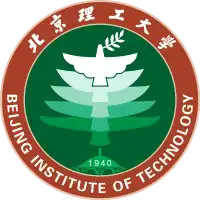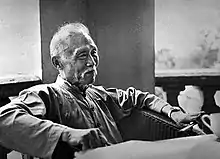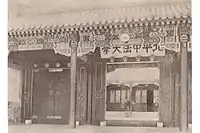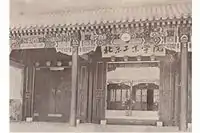 | |||||||
| Motto | 德以明理 学以精工 | ||||||
|---|---|---|---|---|---|---|---|
Motto in English | Seek Truth in Virtue; Pursue Study to Perfect Practice. | ||||||
| Type | Public | ||||||
| Established | 1940 | ||||||
Academic affiliations | Excellence League, SSU, AMBA, BHUA | ||||||
| President | Zhang Jun | ||||||
Academic staff | 1,953 (2010)[1] | ||||||
Administrative staff | 1,489 (2010) | ||||||
| Students | 26,358 (2010)[1] | ||||||
| Undergraduates | 14,010 (2010)[1] | ||||||
| Postgraduates | 8,205 (2010) | ||||||
| 2,701 (2010)[1] | |||||||
| Location | , China 39°57′28″N 116°18′30″E / 39.95778°N 116.30833°E | ||||||
| Campus | Urban, 4,734 ha | ||||||
| Colors | Green and white | ||||||
Sporting affiliations | Beijing Institute of Technology F.C. | ||||||
| Website | bit.edu.cn | ||||||
 | |||||||
| Chinese name | |||||||
| Simplified Chinese | 北京理工大学 | ||||||
| Traditional Chinese | 北京理工大學 | ||||||
| |||||||
.jpg.webp)
The Beijing Institute of Technology (BIT; 北京理工大学) is a public university located in Beijing, China. It was originally established as Natural Science Academy in 1940 in Yan'an, Shaanxi.[2] The university is affiliated with the Ministry of Industry and Information Technology. It is part of Project 211, Project 985, and the Double First-Class Construction.
History
Yan'an period (1940–1946)


Beijing Institute of Technology (BIT) has its origins in the Yan'an Research Academy of Natural Sciences (延安自然科学研究院). BIT was established May 1939 in Yan'an, Shaanxi by the Chinese Communist Party with the aim of training science and engineering professionals.[2] In January 1940 when China was undergoing the most difficult phase of the War of Resistance Against Japan the Central Committee of the Chinese Communist Party reformed the Yan'an Research Academy of Natural Sciences into the Yan'an Academy of Natural Sciences (延安自然科学院). The mission of the academy was to assist industrial development in the Shanxi-Chahar-Hebei Border Region. Opened on 1 September 1940 it was the first science and engineering university founded by the Chinese Communist Party. Li Fuchun, secretary of the CCP Committee for Shaan-Gan-Ning Border Region, was appointed as the first president and was succeeded by educationist Xu Teli.[3]
During the founding period the Yan'an Academy of Natural Sciences received support from international organizations and individuals including Rewi Alley.
In March 1943 the Yan'an Academy of Natural Sciences merged with the newly founded University of Yan'an (延安大学) and was named the School of Natural Sciences University of Yan'an (延安大学自然科学院).
At the end of 1945 the University of Yan'an moved to the north of China.[4]
Shanxi-Chahar-Hebei Border Region period (1946–1949)
In January 1946 the School of Natural Sciences moved to Zhangjiakou. The Central Bureau of Shanxi-Chahar-Hebei Border Region decided to settle the School at Zhangjiakou and merged it with Shanxi-Chahar-Hebei Border Region College of Technology (晋察冀边区工科专门学校) to form the Shanxi-Chahar-Hebei Border Region College (晋察冀边区工业专门学校).
At the end of the same year the Shanxi-Chahar-Hebei Border Region Institute moved to Hebei and merged with the Shanxi-Chahar-Hebei Border Region Academy of Railway (晋察冀边区铁路学院) to form the Shanxi-Chahar-Hebei Border Region College of Industry and Transportation (晋察冀工业交通学院). One year later the Shanxi-Chahar-Hebei Border Region Institute moved to Jingxing County and was renamed the Shanxi-Chahar-Hebei Border Region Bureau of Industry College of Technology (晋察冀边区工业局工业学校). In August 1948 it merged with the Institute of Technology Northern University (北方大学工学院) to form the Institute of Technology North China University (华北大学工学院).[3][4]
Institute of Technology North China University period (1949–1952)


The Institute of Technology North China University made its final move to Beijing and confirmed its academic focus on industrial development for the newly founded People's Republic of China. It was administered by the Ministry of Industry and became the first university specializing in heavy industry since the foundation of the PRC.
The home campus of Sino-French University (中法大学) and its Departments of Mathematics, Physics and Chemistry were merged into the Institute of Technology North China University in October 1950.[3][4]
Beijing Institute of Technology period (1952–1988)
On 1 January 1952 the Institute of Technology North China University was officially renamed the Beijing Institute of Technology (北京工业学院). On 8 March 1952 the Ministry of Heavy Industry declared that the Beijing Institute of Technology would be developed into a higher educational institute specializing in national defense. The Beijing Institute of Technology established a number of weapon science and technology disciplines, including China's first rocket and missile program, with the help of scientists such as Qian Xuesen.[5] Several departments were terminated and many were transferred to other universities such as China Agricultural University (1947), Beijing Steel and Iron Institute (1952) and Beijing University of Aeronautics and Astronautics (1952). In 1959 the Beijing Institute of Technology was singled out as one of 16 “national key universities” that were authorized to offer graduate degrees.
During the Cultural Revolution most research at Beijing Institute of Technology came to a halt but quickly resumed after 1976.[3][5]
Post-economic reform period (1988–present)
In 1988 the institution changed its Chinese name from "Institute" to "University" (北京理工大学) while the English name remained unchanged. In 1991 BIT was chosen as one of the 14 national key universities to receive special supports from the Chinese government during the Eighth Five-Year Plan.
In December 1995 BIT was ratified by the Chinese government as one of the 15 first-tier "Project 211" universities. In 1996 BIT became one of the first 32 Chinese universities to officially run graduate schools. In the same year BIT was designated as one of the 27 national key universities during the Ninth Five-Year Plan. In 1999 BIT's undergraduate education was evaluated as "Excellent" in the assessment organized by the Chinese Ministry of Education.
In 2000, BIT was the tenth university to be admitted into "Project 985" which aimed to promote the development and reputation of the Chinese higher education system by founding world-class universities in the 21st century through prioritized supports from both national and local government funding. In the same year BIT was also designated as one of the top 22 universities in the "21st Century Education Promotion" plan during the Tenth Five-Year Plan.
BIT was administered by the Commission of Science, Technology and Industry for National Defense. Since 2008 it is administered by the newly founded Ministry of Industry and Information Technology.
In November 2010, along with 8 other Project 985 universities, BIT officially formed the Excellence League, an alliance of 10 Chinese universities with strong background in engineering.
BIT is traditionally strong in national defense and military technologies research, especially radar, missiles and armored combat vehicles but also maintained outstanding research strength in electrical engineering, automation, photonics, mechanical engineering, chemical engineering, computer science and industrial design.[5]
As of 2015 BIT has established cooperation with more than 200 universities from 58 countries and implemented student exchange programs with more than 40 universities in the world including the Technical University of Munich, Bauman Moscow State Technical University, Tokyo Institute of Technology, University of California and The Australian National University.[6]
Campus
Zhongguancun, Beijing
BIT's main campus is located in the Zhuongguancun area of Beijing. This area is known for its high concentration of universities, research institutions and high-tech companies as well as knowledge and information industries which give it the name of Silicon Valley of China. BIT is adjacent to the National Library of China, Zhongguancun Science Park and universities such as Renmin University, China Agricultural University, Beijing Foreign Studies University and Minzu University of China.
Zhongguangcun campus has an area of 920,700 square meters, including a floor space of 724,000 square meters.[7] It is the oldest campus of BIT. Since the opening of Liangxiang campus in 2007 Zhongguancun campus is mainly used to host higher year undergraduate students and postgraduate students.[8]
Liangxiang, Beijing

Since 2007 undergraduate students are located on the Liangxiang campus which is based in Liangxiang University Town, Fangshan District of Beijing.[9]
Xishan, Beijing
Xishan Laboratory Research Center is located in Beijing.[10]
Fangshan, Beijing
The BIT Fangshan campus was co-founded by BIT and the Fangshan District government and is located in the Fangshan District of Beijing.
Qinhuangdao, Hebei
Founded in 1984, the Qinhuangdao campus offers one-year pre-university program for ethnic minority students whose first language is not Mandarin. Qinhuangdao campus also accepts pre-university ethnic minority students who will apply to Beihang University, Nanjing University of Aeronautics and Astronautics, Nanjing University of Science and Technology, Harbin Institute of Technology, Harbin Engineering University and Northwestern Polytechnical University.[11]
Zhuhai, Guangdong
The Zhuhai campus is based in the Guangdong province of China. The speciality of Zhuhai campus lies in providing continuing education, distance learning courses and special courses related to the local economy and industry. It is home to many research institutions including a graduate school and a science park. BITZH- CUHK Optomechatronic Engineering Joint Research Center and BITZH- HKPU City and Public Security Joint Research Center are also located in Zhuhai campus.[12]
Academics
Education
BIT has 16 national key disciplines and 25 ministry-level key disciplines. BIT offers bachelor's degrees in 60 majors, Master's degrees in 144 majors and Doctorate degrees in 62 majors. It also has 17 post-doctorate stations.[7]
Research
BIT's research strength lies in electrical engineering, information engineering, automation, photonics, mechanical Engineering, vehicle engineering, aerospace engineering and chemical engineering. Emerging research areas developed in recent years include Computer Science, Industrial Design and Higher education research.
BIT has five national key laboratories (research centers), six national defense key laboratories (research centers), two MOST key laboratories (research centers) and four Beijing municipal key laboratories (research centers).[7] It also has a national key science park. The annual research expenditure in 2004 was more than 620 million RMB.
BIT is one of the Seven Sons of National Defence.[13]
Rankings
| University rankings | |
|---|---|
| Global – Overall | |
| ARWU World[14] | 101-150 |
| QS World[15] | 340 |
| THE World[16] | 251-300 |
| USNWR Global[17] | 298 |
| National – Overall | |
| BCUR National[18] | 16 |
BIT is ranked among the top 20 universities in China and top 300 in the world.[19][20][21] In recent national level evaluations BIT was among the first 15 universities to be designated into the "Project 211". It is also the tenth university to be designated into the prestigious "Project 985".[22] Together with Tsinghua University, Peking University, Beihang University and University of Chinese Academy of Sciences, it is widely considered to be one of the top engineering universities in Beijing.[21]
BIT is ranked 201-300th in the WURI Global Top 100 Innovative Universities Ranking of 2021.[23]
According to the China Discipline Ranking conducted by a research center affiliated with the China Ministry of Education, BIT ranks among top 10 nationally in the following ten disciplines:[24][25]
- Information Engineering: ranked fifth.
- Optical Engineering: ranked fifth.
- Aerospace Science and Engineering: ranked fifth.
- Mechanical Engineering: ranked seventh.
- Metallurgical Engineering: ranked seventh.
- Transportation and Traffic Engineering: ranked ninth.
- Instrument Sciences and Technology: ranked tenth.
- Automation Science and Engineering: ranked tenth.
- Chemical Engineering: ranked tenth.
Note: According to the ranking's classification of academic disciplines, BIT was evaluated in about 20 disciplines.
Library
Established in 1940 the BIT library now consists of one main library and four branch libraries. Nine new branch libraries are in construction or planning.
Renovation of the main library was completed in 2006. The state-of-the-art building has an area of 25,509 square meters and is covered by a wireless network. It has a collection of more than 3 million items, including 1.13 million electronic items.[26]
Press
The BIT Press was established in 1985 and has published more than 3,000 books.[27] Most of the books published by BIT press are in the area of natural science and technology. The current director for the press is Yang Zhijian.
Student life
Student housing
All undergraduate and postgraduate students at BIT are guaranteed university accommodation. Allocation is normally based on the students' major, year and class. First and second year undergraduate students are based at Liangxiang campus. Higher year undergraduate students and postgraduate students are based at Zhongguancun campus. Both campuses provide staff accommodation.
Notable alumni
Among the 100,000 BIT alumni there are Fellows of the Chinese Academy of Science and Chinese Academy of Engineering, officials with rank higher than provincial governor and generals of the Chinese military.
Politicians
- Li Peng, former Premier and Chairman of the National People's Congress (NPC) of China
- Ni Zhifu, former Vice Chairman of the National People's Congress
- Ye Xuanping, vice-president of the Chinese People's Political Consultative Conference (CPPCC). Former Governor of Guangdong
- Zeng Qinghong, former vice-president of China
- Zou Jiahua, former Vice-Premier of the China
Scientists
- Wang Xiaomo, Winner of The State Preeminent Science and Technology Award of China, and also the only one attended college after 1949 among all winners till 2014, Father of Chinese Airborne early warning and control system.
- Huang Chunping, Director of Rocket System for the Shenzhou 5 Spacecraft.
- Peng Shilu, "Father of Chinese Nuclear Submarine".
Athletics
BIT has several collegiate sports teams. Its football team is widely considered one of the best in Chinese collegiate football. The team won 4 out of 6 national championships from 2001 to 2006 in the Chinese University Football League. The BIT team also represented Chinese football at the 2003 Summer Universiade Games and the 2005 Summer Universiade Games.[28] After being promoted to the professional football league in 2006 the team has been participating in the professional Chinese Football Association Jia League. Since 2015 the international students at BIT have their own football team called the BIT International FC.
The Eastern Athletic Field is the home field for Beijing Institute of Technology FC. It is mostly used for the team's home games. The field is also open to students and staff of BIT.
See also
References
- 1 2 3 4 "Facts And Figures". Beijing Institute of Technology website. Archived from the original on 2013-12-27. Retrieved 2013-01-21.
- 1 2 "General Information of Beijing Institute of Technology (BIT)". Official website of Beijing Institute of Technology. Retrieved 15 September 2020.
- 1 2 3 4 "辉煌校史_北京理工大学迎新网". i.bit.edu.cn. Archived from the original on 2016-09-27. Retrieved 2016-03-28.
- 1 2 3 "历史沿革_北京理工大学". www.bit.edu.cn. Retrieved 2016-03-28.
- 1 2 3 Sullivan, Lawrence (2015). Historical Dictionary of Science and Technology in Modern China. Maryland, United States of America: Rowman & Littlefield Publishers. p. 42. ISBN 978-0810878549.
- ↑ "学校简介_北京理工大学". www.bit.edu.cn. Retrieved 2016-03-28.
- 1 2 3 "Facts And Figures". Beijing Institute of Technology website. Archived from the original on 2007-10-27. Retrieved 2008-02-16.
- ↑ "地理位置_北京理工大学". www.bit.edu.cn. Retrieved 2016-03-28.
- ↑ "校区概况 -- 北京理工大学良乡校区管理处". liangxiang.bit.edu.cn. Archived from the original on 2016-10-12. Retrieved 2016-03-28.
- ↑ "Welcome to Beijing Institute of Technology(BIT)". english.bit.edu.cn. Retrieved 2016-03-28.
- ↑ "BIT Qinhuangdao Campus". english.bit.edu.cn. Retrieved 2016-03-28.
- ↑ www.weihaiseo.com. "Beijing Institute of Technology, ZHUHAI_Welcome to Beijing Institute of Technology, Zhuhai". guojihz2013.zhbit.com. Archived from the original on 2016-04-08. Retrieved 2016-03-28.
- ↑ Cong, Forest (4 June 2020). "US Ban on Chinese Students With Military Links Divides Experts on Impact". www.voanews.com. Retrieved 15 June 2021.
- ↑ "Academic Ranking of World Universities 2023". Shanghai Ranking Consultancy. 2023. Retrieved August 15, 2023.
- ↑ "QS World University Rankings® 2024". Quacquarelli Symonds Limited. 2023. Retrieved August 16, 2023.
- ↑ "World University Rankings 2024". THE Education Ltd. Retrieved September 28, 2023.
- ↑ "2023 Best Global Universities Rankings". U.S. News & World Report LP. Retrieved October 31, 2022.
- ↑ Best Chinese Universities Ranking, Overall Ranking - 2023
- ↑ "ShanghaiRanking's Best Chinese Universities Ranking". www.shanghairanking.com. Archived from the original on 2022-04-25. Retrieved 2022-11-01.
- ↑ "ShanghaiRanking-Beijing Institute of Technology". www.shanghairanking.com. Retrieved 2023-08-15.
- 1 2 "US News Best Global Universities for Engineering in Beijing". US News. Retrieved 10 November 2022.
- ↑ "BEIJING INSTITUTE OF TECHNOLOGY". english.bit.edu.cn. Retrieved 2023-08-16.
- ↑ "Global Top 100 Innovative Universities - WURI". WURI. Retrieved 2021-10-15.
- ↑ "China University Disciplines Ranking 2002-2004". Sina.com website. Retrieved 2008-02-16.
- ↑ "China University Disciplines Ranking 2006". China Education Online website. Retrieved 2008-02-16.
- ↑ "Introduction to the BIT Library". Beijing Institute of Technology website. Archived from the original on 2008-06-05. Retrieved 2008-02-16.
- ↑ "Introduction to the BIT Press". Beijing Institute of Technology website. Archived from the original on 2007-09-05. Retrieved 2008-02-16.
- ↑ "Introduction to the BIT FC". Sina.com website. Retrieved 2008-02-22.
External links
- Official website
- International Students Center
- Website of the BIT Press (in Chinese)
- Website of the BIT Library (in Chinese)